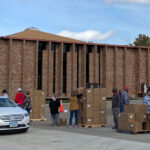By Lindsay Steele
The Catholic Messenger
For generations, Catholics have felt the beads of the rosary pass through their fingertips as they contemplate the Christian faith through Mary’s eyes. They’ve also dealt with naysayers who claim, incorrectly, that the rosary is not scripturally based and that it’s all about mindless repetition and worship of Mary.

St. Vincent School students in Keokuk pray a living rosary in the school gymnasium earlier this month.
Those who faithfully pray the rosary — from popes to persons in the pew — are quick to dispel these misconceptions. They also testify to the positive impact that praying the rosary has had on their lives, whether they pray alone, as a family or with a group.
“Is there any other prayer where, for 10-30 minutes, you are holding the crucifix, meditating on the life of Christ and the mysteries of Christ?” asks Father Bill Kneemiller, a priest of the Diocese of Davenport who has served overseas as a chaplain for the U.S. Army Reserves. “Mary leads us directly to Christ.”
St. John Paul II once described the rosary as an echo of the prayer of Mary, her perennial Magnificat for the work of the redemptive incarnation which began in her virginal womb. “The rosary, though clearly Marian in character, is at its heart a Christ-centered prayer. It has all the depth of the gospel message in its entirety,” he said in his apostolic letter, Rosarium Virginis Mariae.
History of the rosary
The evolution of the rosary is widely debated, although theologians generally conclude that it is an outgrowth from the early monks reciting the psalms and using pebbles or knotted string to keep track, according to Our Sunday Visitor. The Vatican began promoting the rosary for universal use in the mid- 16th century.
How to pray
The rosary begins with the Apostles’ Creed, which summarizes the great mysteries of the Catholic faith. The Our Father, which introduces each mystery, is from the Gospels. Ten Hail Marys follow the introduction of each mystery.
The four sets of mysteries of the rosary center on the events of Christ’s life; the joyful, sorrowful, glorious and luminous. The five joyful mysteries are traditionally prayed on Mondays, Saturdays and, during Advent, on Sundays. The five sorrowful mysteries are traditionally prayed on Tuesdays, Fridays and, during Lent, on Sundays. The five glorious mysteries are traditionally prayed on Wednesdays and, outside of Advent and Lent, on Sundays. The five luminous mysteries are traditionally prayed on Thursdays. The faithful can choose to pray the rosary with a specific intention in mind; for example, St. Wenceslaus Parish in Iowa City hosts a monthly pro-life rosary.
It bears repeating
The rosary is intended to be a contemplative prayer. In the early 20th century, Pope Paul IV warned Catholics not to get into the habit of quick, mindless repetition of the prayers of the rosary. “Without contemplation, the Rosary is a body without a soul, and its recitation runs the risk of becoming a mechanical repetition of formulas, in violation of the admonition of Christ. … By its nature the recitation of the Rosary calls for a quiet rhythm and a lingering pace, helping the individual to meditate on the mysteries of the Lord’s life as seen through the eyes of her who was closest to the Lord. In this way the unfathomable riches of these mysteries are disclosed.”
The rosary in real life
Wayne Kneeskern, a member of Ss. Joseph and Cabrini Parish in Richland, designed a rosary steering wheel cover in 2010. He sells his “travel rosaries” online, offering people the opportunity to pray the rosary in the car more safely. Having lost his wife five years ago, Kneeskern turns to the rosary now more than ever. “When we went anywhere, she always had a rosary in her hand. Now, I feel close to her by praying while I am driving alone,” he said. “I’m still learning how to live alone after 46 years of marriage, and the rosary has been a guide to help through the rough times and made it easier to go on.”
Fr. Kneemiller believes praying the rosary had a huge role in his discernment to the priesthood. “I was invited to join a family rosary back in the early 1990s. The family prayer leaders began with a simple invocation that they would ‘Pray from their hearts,’ and they did pray from their hearts,” he recalled. “They took their time to pray, which was like talking to God, and they didn’t rush. Soon after that, I began praying the daily rosary myself, and a year later, I started to look into the seminary!”
Father Mike Spiekermeier arrives about a half-hour before his scheduled daily Masses at Atrium Village in Hills so he can lead a dozen residents in the praying of the rosary. He is the pastor of St. Joseph Parish next door. “I think that it has just become a regular thing to do before Mass,” he said, noting their desire to meet early to pray the rosary. It’s also common for him to see members of the Hills parish praying the rosary before weekend Masses at the church.
St. James Parish in Washington has embarked on a “1,000 rosary Lent” challenge. “It is our goal to pray 1,000 rosaries during Lent,” said Father Bernie Weir, the parish’s pastor. Each week, parishioners will be asked to report how many rosaries they have prayed in their home. “We need at least 25 per day to meet our goal.”
Tom and Eileen Heinold, members of St. Paul the Apostle Parish in Davenport, pray the rosary nearly every day with their 13-year-old daughter, Meredith, because they feel it draws them all closer to Jesus through Mary. They believe it helps bind them as a family as well. “As it has so often been said, ‘a family that prays together stays together,’” Tom said. It has also provided great comfort during difficulties or times of deep sadness, Eileen noted. “Most importantly, the rosary is a powerful weapon against sin, and our Blessed Mother has told numerous saints to pray the rosary. Since we are all called to be saints, what better way to go about it than to do as Jesus’ own mother asks and meditate upon the Gospel by reciting the prayers of the rosary?”
Learn to pray the rosary
Most parishes have pamphlets and other resources on praying the rosary. The U.S. Conference of Catholic Bishops’ website also has information on praying the rosary at http://www.usccb.org/prayer-and-worship/prayers-and-devotions/rosaries/how-to-pray-the-rosary.cfm.











